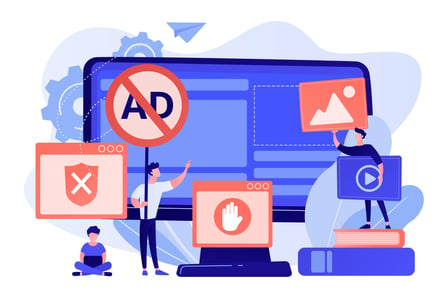10 Essential Tips to Protect Your Website from the Ad Block Apocalypse
February 12, 2024In a world where ad-blocking software has become ubiquitous, website owners and digital marketers face a new challenge: how to protect their websites from the ad block apocalypse. With ad revenue at stake, it's crucial to find ways to overcome this obstacle and ensure that your website continues to generate income and engage visitors. Fortunately, there are several essential tips that can help you navigate this landscape.
One key strategy is to focus on providing high-quality, valuable content that users won't want to block. By creating engaging and meaningful experiences for your audience, you can build a loyal following and decrease the likelihood of your ads being blocked. Additionally, opting for native advertising or sponsorship opportunities instead of traditional banner ads can also help circumvent ad blockers.
However, it's important not to rely solely on content. Optimizing your website's performance, improving its loading speed, and carefully managing your ad placements are also crucial steps in navigating the ad block apocalypse. By understanding the user experience and taking proactive measures to address their concerns, you can mitigate the impact of ad-blocking software and protect your website's revenue stream.
Don't let the ad block apocalypse bring your website down. Implement these ten essential tips today and safeguard your site against the ever-present threat of ad-blocking.
Understanding the importance of website security
In today's digital landscape, website security is of utmost importance. With the widespread use of ad-blocking software, website owners and digital marketers face the challenge of protecting their websites from the ad block apocalypse. Ad revenue is at stake, and it's crucial to find ways to overcome this obstacle and ensure that your website continues to generate income and engage visitors.
Tip 1: Optimize your website for fast loading times
One of the key factors that can contribute to ad-blocking software is slow loading times. Users are more likely to block ads if they have to wait for a long time for a page to load. To protect your website from the ad block apocalypse, it's essential to optimize your website for fast loading times.
There are several steps you can take to achieve this. First, make sure that your website is hosted on a reliable and fast server. Additionally, optimize your images and videos to reduce their file sizes without compromising on quality. Minify your CSS and JavaScript files, and enable caching to improve page load times. By prioritizing speed, you can provide a better user experience and decrease the likelihood of your ads being blocked.
Tip 2: Use non-intrusive ad formats
Ad-blocking software is often triggered by intrusive and annoying ads that disrupt the user experience. To protect your website from the ad block apocalypse, it's important to use non-intrusive ad formats that are less likely to be blocked.
Consider using native ads, which blend seamlessly with the content of your website and provide a more organic and less intrusive advertising experience. Native ads are often perceived as more valuable and relevant by users, which increases the chances of them being accepted and not blocked. By opting for non-intrusive ad formats, you can maintain a positive user experience and mitigate the impact of ad-blocking software.
Tip 3: Diversify your revenue streams
Relying solely on ad revenue can be risky in the face of the ad block apocalypse. To protect your website's income, it's crucial to diversify your revenue streams.
Consider exploring alternative monetization strategies such as affiliate marketing, sponsored content, or creating and selling your own digital products. By diversifying your revenue streams, you can reduce your reliance on ads and ensure a more stable income for your website.
Tip 4: Implement native advertising
As mentioned earlier, native advertising can be an effective strategy for navigating the ad block apocalypse. Native ads seamlessly integrate with your website's content, providing a more natural and engaging advertising experience.
To implement native advertising, partner with relevant brands or advertisers and create sponsored content that aligns with your website's niche. By providing valuable and relevant content that is clearly labeled as sponsored, you can maintain transparency and build trust with your audience. Native advertising not only helps protect your website from ad-blocking software but also enhances the overall user experience.
Tip 5: Enhance user experience through responsive design
A crucial aspect of protecting your website from the ad block apocalypse is to prioritize user experience. Users are more likely to block ads if they have a negative experience on your website.
Invest in responsive design to ensure that your website is accessible and visually appealing across different devices and screen sizes. A responsive design adapts to the user's device, providing a seamless and enjoyable browsing experience. By enhancing user experience through responsive design, you can increase engagement and decrease the likelihood of your ads being blocked.
Tip 6: Utilize anti-ad-blocking scripts and tools
To combat ad-blocking software, you can utilize anti-ad-blocking scripts and tools. These scripts and tools detect ad blockers and can prompt users to disable them or whitelist your website.
Consider implementing anti-ad-blocking scripts that display polite messages encouraging users to support your website by disabling their ad blockers. Additionally, some tools allow you to create customized experiences for users with ad blockers, such as displaying alternative content or offering subscription-based options. By utilizing these scripts and tools, you can encourage users to support your website while protecting your ad revenue.
Tip 7: Create engaging and valuable content
One of the most effective ways to protect your website from the ad block apocalypse is to focus on creating engaging and valuable content. Users are less likely to block ads if they find your content valuable and engaging.
Invest in content creation that provides real value to your audience. Conduct thorough research, offer unique insights, and provide actionable information that users can benefit from. By consistently delivering high-quality content, you can build a loyal following and decrease the likelihood of your ads being blocked.
Conclusion and final thoughts on protecting your website from ad blockers
The ad block apocalypse poses a significant challenge for website owners and digital marketers, but with the right strategies in place, it's possible to protect your website and revenue stream. By optimizing your website's performance, using non-intrusive ad formats, diversifying your revenue streams, implementing native advertising, enhancing user experience through responsive design, utilizing anti-ad-blocking scripts and tools, and creating engaging and valuable content, you can navigate this landscape and safeguard your website from the impact of ad-blocking software. Don't let the ad block apocalypse bring your website down. Implement these ten essential tips today and ensure the continued success of your website.



